Are you looking to convert your website into a mobile app? With millions of mobile applications available to download already, you’d be far from the first.

Whether you think it's for better or for worse, smartphones have changed the world. We now access information at the touch of a screen, and everything you need to know about a brand can be found in moments. Consumers no longer need a desktop computer to explore your website, as over half of all visits to websites in 2023 came from mobile devices.
If your company has a website, you can convert your site into an Android or iOS app and offer a more valuable mobile-friendly experience. Why launch a mobile app? An app and app store listing will enhance your company’s credibility. Native app features and integrations offer functionality not possible through a website. And your app icon on a user’s mobile device home screen, along with push notifications, will drive engagement and retention — which can directly lead to increased revenue.
In this post, we'll discuss:
- why your business might need a mobile app
- whether your app should be iOS or Android (or both)
- variables to consider when creating a mobile app
- how to convert a website into a mobile app
- examples of quality mobile apps adapted from websites
That's a lot to cover, so let's get started
Why do you need a mobile app?
Mobile applications bring many benefits to customers and businesses — it's why nearly a third of small businesses already have one. Below are a few reasons why you might want to convert your site into a mobile app.
Ease of Access
Once a user installs an app, it’s much easier to open and engage with that application than it is to open a website in a separate browser application. Fewer barriers between the user and your content is always a good thing.
According to recent research, mobile users spend 83% of their time in apps compared to 17 in web browsers — we suspect this is due in large part to the convenience of having an application right on the home screen.
Of course, there's the challenge of getting the user to isntall your app in the first place — see our guide to converting mobile traffic to app downloads to help with that.
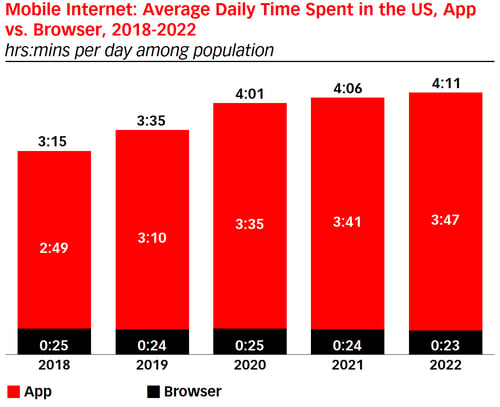
Search Engine Optimization
Search engines like Google are designed to provide the most relevant results based on your search. It makes sense that by having a mobile app, your website will rank higher in search as more people use mobile devices to browse the internet.
For example, if someone searches for your brand or products on their phone, they'll have a better chance of getting the information they're looking for if your company offers a mobile app.
Keeping in mind that Google will want to provide the best answer possible, it will display your app as an "app pack" when someone searches for your brand on a mobile device (depicted below). Google will see that the user is operating on mobile and will want to show results that are best suited for that interface.
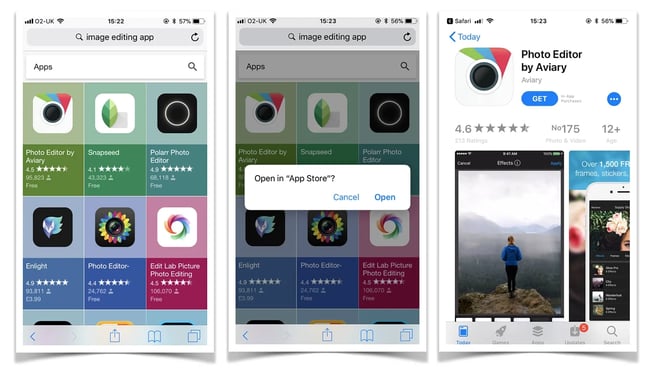
Mobile-Friendly Interface
It's pretty disheartening to see that your favorite brand or product has an awesome website on desktop — but when you load it on your phone or tablet, the mobile version pales in comparison.
As a marketer, website owner, and/or web developer, your job is to create an experience that users will enjoy, but what if your site isn't geared for mobile? Should you tear it down and start from scratch, take on a website redesign, or try to patch the flaws potentially leading to more issues in the future?
One option is to create a mobile app for your website instead. This way, you keep your desktop version the same while offering a mobile variant that's more user-friendly.
Push Notifications
One of the biggest advantages of mobile apps is the ability to send push notifications to users. You can proactively notify customers about sales, personal offers, new posts, and more without them clicking on and opening your app.
When push notifications are enabled, your alerts appear on the user's locked or home screen so they can see your messages as soon as they check their phone.
Integrations
Another perk of converting your website into a mobile app is that mobile apps have access to features on your phone that a website does not.
For instance, you can add biometric login, access phone contacts, camera functions, and other mobile device features like GPS to make your user experience even more immersive.
You can also integrate your iOS and Android apps with third-party vendor-provided SDKs to provide advanced functionality, including deferred deep linking, app install ad attribution, in-app video calling, in-app chat, and a lot more.
Multi-Touch Feature
Multi-touch is a feature only available for iOS or Android apps. There are various gestures like swiping, pinching, and more that you can use to interact with an app. As a result, users get a more personalized, engaging, and habitual experience versus what they would get with a desktop browser.
Offline Mode
During travel, and when in areas with weak or no internet connection, users may not be able to access your website. Mobile apps provide offline functionality so that your users can still access some aspects of your app regardless of their connectivity.
For example, you may provide functionality to download audio, video, or other content for later offline consumption, Or you may offer functionality so that users can enter data while offline that can be later uploaded when back online – think notes from a meeting or job site visit.
Ready to get started with your mobile app? First, we need to decide if your app will be offered on Android, iOS, or both.
Should my mobile app be Android or iOS?
Android and iOS are different platforms requiring different apps. You may have to decide whether to focus on one platform or the other, or to build an app for each platform. In an ideal world, you'd probably want to offer your app to both types of users. However, you may have to make a tough decision if you don't have the bandwidth or resources to build two unique apps.
For starters, Android does have a larger global user base than iOS. In Q1 2024, the overall Android OS market share was 70.8%, whereas the iOS market share was 28.5%. Globally, more Android devices are in use than iOS devices.
With that in mind, it's also important to consider where your users are located. While Android is more popular worldwide, iOS is more popular in countries such as Japan, Canada, Norway, and the U.S. See the chart below from app development platform Median.co for a complete breakdown by region.
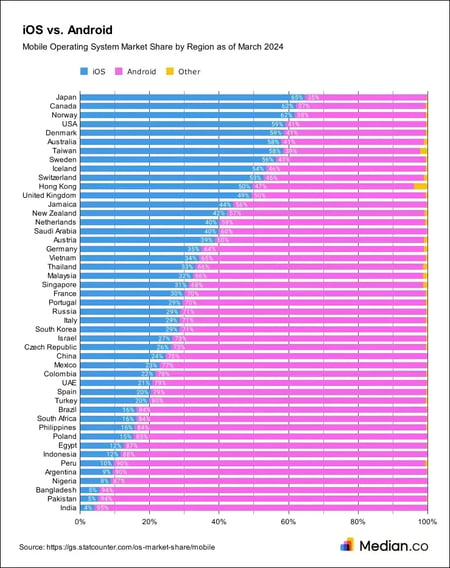
Both operating systems offer comparable functionality, and you can build an app for both platforms if you choose. However, the underlying code for iOS and Android is completely different. This means if you decide you need an app for both Android and iOS, you can, but you'll just need to build two separate apps — even if they offer the same exact features.
Another difference between Android and iOS is the app store approval guidelines. Apple's guidelines are very strict — it tends to only approve engaging and useful mobile apps that utilize features, content, and UI that elevate the app beyond a basic website. While you can indeed convert your website into an app, the end product must look and feel like an app. According to Apple, "If your app is not particularly useful, unique, or ‘app-like,’ it doesn’t belong on the App Store." Therefore, it's more common for websites that are converted into iOS apps to be rejected by the Apple App Store reviewers.
Apple also pays attention to the user interface (inappropriate UI is the most frequent rejection reason). It offers "Human Interface Guidelines" and "UI Design Dos and Don'ts" for designers and developers to follow. If your app’s user interface is built using your web content, it’s critical to ensure it meets Apple’s requirements. If Apple feels your app's interface is substandard, it will reject it from the App Store.
Now that we're ready to begin app development, let's review some important factors before getting started.
Variables to Consider When Converting Websites to Mobile Apps
There are different approaches to converting websites into mobile iOS and Android apps. The approach you take will depend on the requirements and goals you have for your app. Here are a few variables you should consider before making the leap from website to app:
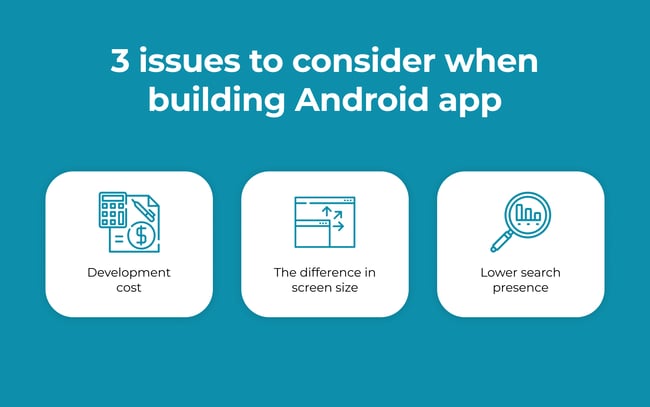
Development Cost
Apps are different from websites in the sense that you can't use a low-cost builder tool like a content management system to make them. You'll likely need a developer or development team in your ring.
Native app development can cost a lot. However, it's better to invest some money at the start of the process and get a good result right away, rather than paying a service over and over again to create the interface you're looking for.
We'll talk more about pricing in the next section, but when you're paying thousands of dollars to build an app, you'll want to get an idea of the total cost of the project before committing to app development.
Screen Size
The mobile market is full of unique devices, including multiple types of smartphones and tablets. So, when creating a UI/UX design, you should consider different screen sizes and ensure that all images, charts, and buttons look great on various devices.
Pro Tip: to avoid problems, you should cooperate with an experienced and skilled UI/UX designer.
Search Presence
Typically, people will search for your website more than they'll search for your mobile app. While Google will help by adding "app packs" to search results, you can also add a popup on your website to tell users about your mobile app. This will encourage people to download your app, especially if your site isn't responsive on mobile.
With all of our bases covered, let's put our plan into action and discuss how you can convert your website into a mobile app.
How to Convert a Website into Mobile App
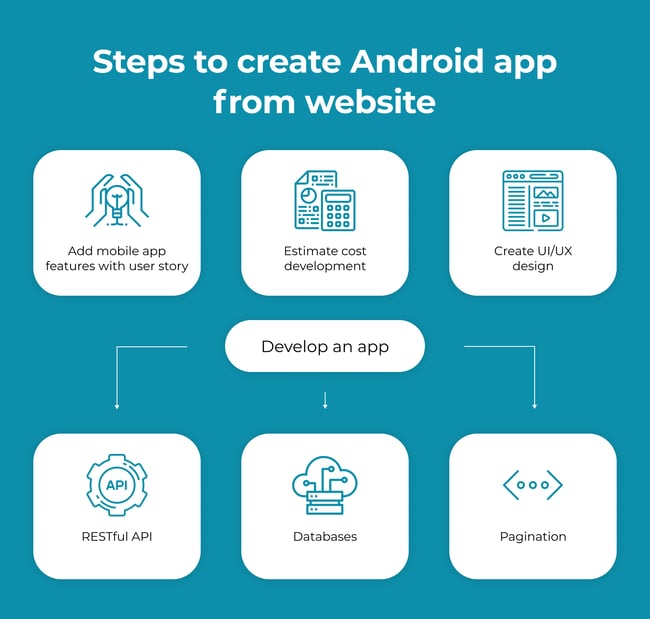
1. Determine if you need a mobile app.
If you've got this far, chances are you're moving towards app development. However, we should note that not every website requires a mobile app. If your website is already mobile-friendly, you may not need an app to improve your customer experience. In that case, a mobile app just may be extra work that might not pay off if more users simply prefer your website.
Here are some questions you can ask yourself to see if a mobile app makes sense for your business. The more "no's" you have, the more likely it is your company would benefit from having a mobile app.
- Is my website responsive and mobile-friendly?
- Is my website only for marketing purposes or do users visit to “get something done”?
- Are there app-specific features that would elevate the experience of an app versus my website?
- How important is an app to the future success of my business?
- Do my competitors offer a mobile app?
- Are my customers asking for an app?
2. Create a list of required features for your app.
Before you dive headfirst into app development, it's important to consider what features you'll include on your mobile app. Not only does this give you an idea of what you'll need to build, but it will help you calculate costs and stay within budget.
After all, it's easy to get carried away thinking about all the possible functions your app can perform. However, by coming up with a vetted list of features, you'll create an attainable vision for your app and ensure every one of its features is useful to your target audience — rather than just being a flashy extra.
3. Select a development approach.
These days there are three options to develop a mobile app — hire an in-house team, outsource app development, or choose an app development platform.
All three approaches have pros and cons. For example, an in-house team tends to be more expensive. You'll need to pay for things like rent, hardware, software, taxes, vacations, and more. However, in-house development allows you to control the development process completely and create an app that's tailored to your exact specifications.
Outsourcing tends to be a cheaper option since you can hire developers internationally at lower rates. The downside of this is that you can't oversee every aspect of development and you have to trust that you've hired the right people to do the job. You’ll want to regularly check in to ensure you aren’t delivered an app that looks nothing like your original blueprint after waiting for weeks or even months for your developers to build it.
A third option is to leverage an app development platform to deliver iOS and Android apps powered by your website content. This approach is often favored by SMBs and larger enterprises who have web development expertise but lack iOS and Android talent. Opting to use a platform to develop your app can result in cost and time savings versus developing an app from scratch but you may be limited if you want to offer functionality not supported by the platform.
4. Estimate app development costs.
Once you have your feature list ready to go and have considered the different development approaches, it's time to start crunching numbers. A good rule of thumb is that the more complex your app is, the more expensive it's going to be to develop. In fact, one study found that a "simple app" costs anywhere between $38,000 and $91,000 to develop from scratch.
Luckily, if you go the app development platform route, you’ll see costs drop by an order of magnitude as you’ll benefit from the scale of a solution that’s built hundreds of thousands or millions of apps. While a complex app might still cost $10,000 to develop, you may be able to launch a simple app for less than $1,000.
5. Create a user-friendly UX design.
Aside from the basic functionality of your app, your UX design is the most important factor to prioritize when building your interface. After all, what's the point of developing a mobile app if it's not as responsive as your website?
If you can't make your mobile app more mobile-friendly than your website, then you may want to consider investing more in your website's design than building a brand new app.
If you're looking for tips to improve user experience, check out this complete guide to UX design.
6. Test your app.
Like with any landing page, social media post, or email campaign, you should test your app before submitting it to the app store. This will allow you to fine-tune your app's features and fix any glitches or flaws before your users discover them.
Not only will this help you retain users who might have deleted your app after experiencing these issues, but it will also save your support team time from having to respond to customers who are having problems with your mobile app. Even if you can't fix all of the flaws before pushing it live, at least you'll be aware of potential issues and can prep your service team before they're exposed to these types of inquiries.
7. Submit your app to app stores.
Once your app is ready to launch, the final step is to submit it to the app stores for review and hopefully approval. Both the Apple App Store and Google Play Store have a review process wherein a reviewer will test your app to verify functionality and compliance with their respective policies.
While you need to be diligent to ensure a successful approval, it’s possible your initial submission may be rejected. If so, don’t be discouraged – the rejection reason will hopefully be addressable and you can resubmit with success.
However, the app store reviewer will only call out the rejection reason and they will not provide guidance on a solution. Similar to getting any other type of professional advice, you’ll want to ensure you’re working with an expert who can help guide you to a solution.
8. Ongoing updates
Investing in your app doesn’t stop once you’ve launched and started onboarding users. You’ll want to continue to update your app with new features and functionality, and keep your app relevant for users in the ever-changing and innovating mobile market. You’ll also be forced to keep your app updated to support the latest iOS and Android devices and software updates, as well as changing app store policies.
To ensure no surprises — such as your app suddenly being removed from an app store — make sure to update your app at least every 6-12 months. You can keep your app updated through an ongoing contract with your app developer (a contract will help make sure they’re there for you when you need them), or by way of updates provided by your chosen app development platform.
Examples of Apps Converted from Websites
What might a website look like when successfully converted into a mobile app? To give you a better sense of where to take your app’s design here are some notable examples of websites converted into mobile applications.
The New Yorker
Since its inception, the New Yorker has adapted from print to website to mobile application. The desktop version of the website serves news stories, opinion pieces, cartoons, a shop, and more.
Looking at the mobile app version of the New Yorker’s website, we can see how it adopts the visuals of the website while providing all the same features — even down to the crossword puzzles.
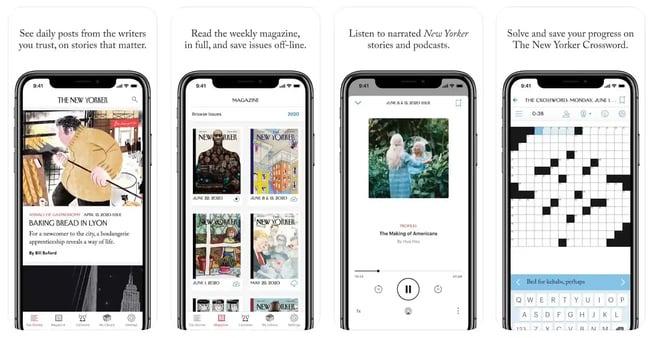
H&M
Many online stores adapt their desktop websites to the mobile realm with apps. Take H&M, for instance: Its mobile app provides a comparable shopping experience to the website, and allows you to tailor your experience to your preferences.
One cool perk exclusive to the app is its scanning feature: Use your phone’s camera to scan the price tag of an item in-store to see whether the store has more of the item in stock.
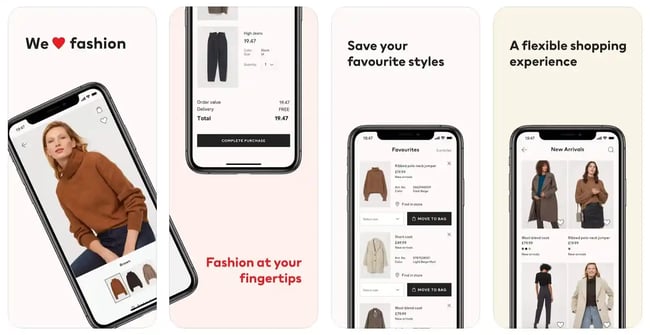
Blue Apron
Blue Apron provides meal kits to give home cooks a helping hand with their ingredients. On the website, members can order their meals and manage their subscriptions. By converting its service into a mobile app, Blue Apron has made it even easier for customers to explore new recipes, save their favorite recipes, and manage their accounts.
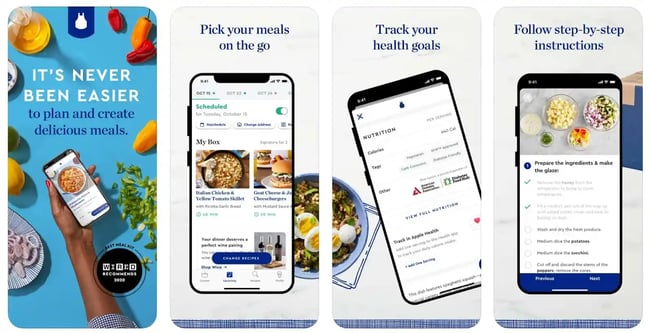
Calendly
Calendly is a scheduling application for professionals. To accommodate on-the-go users, the company created a mobile application for iOS and Android to provide access to its essential features. Users can schedule meetings, review and modify appointments, and book meetings on the clean mobile interface.
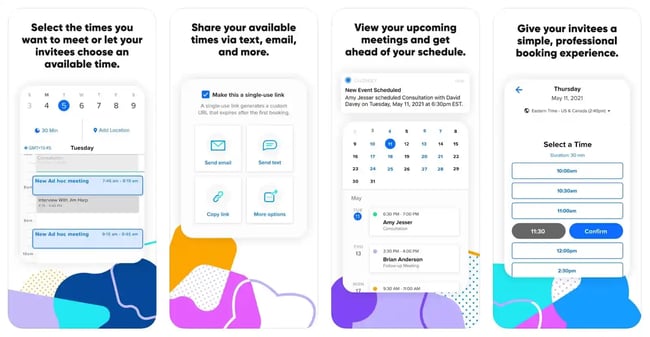
Canva
Like Calendly, design company Canva took the strengths of its web application and condensed them into a mobile app version to reach a wider customer base. It allows you to make customized graphics, edit photos, and even edit short videos on your phone.
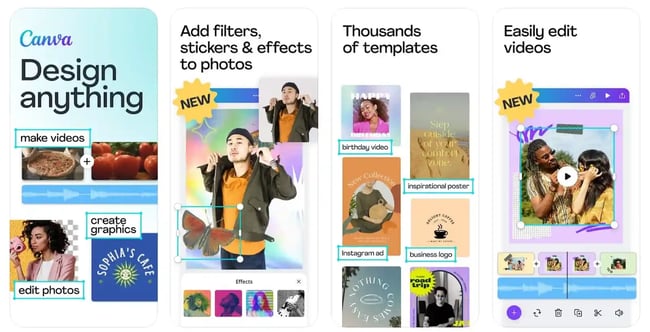
Optimizing Your Mobile App
Web behavior is changing, and to build a successful website, you need to adapt your content to match how people are searching for information. In this case, that means building a mobile app that's user-friendly and resourceful to those who are searching for your brand on a phone or tablet.
By following the steps outlined above, you can convert your website into an engaging mobile app and create a better on-the-go experience for your customer base.
Editor's note: This post was originally published in April 2021 and has been updated for comprehensiveness.





![How to Build & Run an Effective Website With a Small Team or Budget [Startup Tips]](https://blog.hubspot.com/hubfs/website-on-a-budget.jpg)



![How to Make a Website With User Accounts and Profiles [With WordPress, Wix, and More]](https://blog.hubspot.com/hubfs/how-to-create-user-accounts-and-profiles.jpeg)

